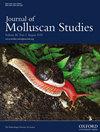利用基于地标的尺寸测量改进蜗牛外壳体积估算
IF 1.2
4区 生物学
Q2 MARINE & FRESHWATER BIOLOGY
引用次数: 0
摘要
数字藏品和出版物中的贝壳图像为研究腹足类体型提供了分类学、地理和形态学的广泛方法。由于传统的线性尺寸测量无法在形态不同的分类群中直接进行比较,我们建议过渡到基于里程碑的尺寸测量,这种测量对形状差异不太敏感。使用两个研究系统对传统和基于里程碑的尺寸测量进行了比较:36个来自贝劳群岛的双壳微细胞标本和66个来自罗斯福野生动物收藏馆(RWLC;位于美国纽约州锡拉丘兹市纽约州立大学环境科学与林业学院)的海洋、淡水和陆地腹足类贝壳。在比较同科标本时,使用Belau双微肽来评估尺寸测量的有效性。该研究系统对方法引入的方差最为敏感。RWLC外壳用于评估在比较形态上不同的分类群时的测量有效性。对从2D图像中测量的总共七个尺寸变量进行了比较,其中三个变量基于夹层标记距离,四个变量基于线性外壳尺寸。基于里程碑的尺寸测量是质心尺寸,一种被称为尺寸调整平均值(SAM)的新测量方法及其重新缩放版本SAM1/3。基于线性尺寸的测量是壳体高度和宽度的最大值、平均值和几何平均值,以及锥形体积(与试样尺寸相似的锥形体积)。通过将外壳体积与每个尺寸测量值进行回归来评估测量精度。对于贝劳双壳类,质心大小和最大外壳尺寸最准确地预测了外壳体积。对于RWLC壳体,圆锥体积、SAM1/3和几何平均壳体尺寸是最准确的预测因素。通过计算%测量误差(%ME)来评估重复性。贝劳双壳类的最大壳体尺寸可重复性最高(%ME=4.19%),其次是质心尺寸(7.76%)。RWLC壳体的锥形体积(%ME=0.0039%)和最大壳体尺寸(0.0073%)可重复性最强。在这两个研究系统中,SAM1/3是对缺失地标最稳健的基于路标的尺寸测量,其次是质心尺寸。基于这些发现,我们建议使用质心大小来比较同源或同科标本,并使用锥形体积来比较形态或分类学上不同的标本。但是,当壳体高度或宽度数据不可用时,无法计算锥形体积。在这种情况下,我们建议使用SAM1/3比较形态不同的外壳。本文章由计算机程序翻译,如有差异,请以英文原文为准。
Improving external shell volume estimation in snails using landmark-based size measurements
Shell images in digital collections and publications enable taxonomically, geographically and morphologically broad approaches to studying gastropod body size. Because traditional linear size measurements are not directly comparable across morphologically disparate taxa, we propose a transition to landmark-based size measurements, which are less sensitive to shape differences. Traditional and landmark-based size measurements were compared using two study systems: 36 specimens of diplommatinid micromolluscs from the Belau archipelago and 66 marine, freshwater and terrestrial gastropod shells from the Roosevelt Wild Life Collections (RWLC; housed at the State University of New York College of Environmental Science and Forestry, Syracuse, NY, USA). Belau diplommatinids were used to assess the effectiveness of size measurements when comparing confamilial specimens. This study system was most sensitive to methodologically introduced variance. RWLC shells were used to assess measurement effectiveness when comparing morphologically disparate taxa. A total of seven size variables measured from 2D images were compared, three variables based on interlandmark distances and four based on linear shell dimensions. Landmark-based size measurements were centroid size, a proposed new measurement dubbed size adjusted mean (SAM) and its rescaled version, SAM1/3. The linear dimension-based measurements were maximum, mean and geometric mean of shell height and width, as well as conical volume (volume of a cone with similar dimensions to specimen). Measurement accuracy was assessed by regressing external shell volume against each size measurement. For Belau diplommatinids, centroid size and maximum shell dimension most accurately predicted external shell volume. For RWLC shells, conical volume followed by SAM1/3 and geometric mean shell dimension were the most accurate predictors. Repeatability was assessed by computing % measurement error (%ME). Maximum shell dimension was most repeatable (%ME = 4.19%) for Belau diplommatinids, followed by centroid size (7.76%). Conical volume (%ME = 0.0039%) and maximum shell dimension (0.0073%) were most repeatable for RWLC shells. In both study systems, SAM1/3 was the land-mark-based size measurement most robust to missing landmarks, followed by centroid size. Based on these findings, we recommend using centroid size to compare congeneric or confamilial specimens and using conical volume to compare morphologically or taxonomically disparate specimens. However, conical volume could not be calculated when shell height or width data are unavailable. In such cases, we recommend comparing morphologically disparate shells using SAM1/3.
求助全文
通过发布文献求助,成功后即可免费获取论文全文。
去求助
来源期刊

Journal of Molluscan Studies
生物-动物学
CiteScore
3.00
自引率
8.30%
发文量
36
审稿时长
3 months
期刊介绍:
The Journal of Molluscan Studies accepts papers on all aspects of the study of molluscs. These include systematics, molecular genetics, palaeontology, ecology, evolution, and physiology. Where the topic is in a specialized field (e.g. parasitology, neurobiology, biochemistry, molecular biology), submissions will still be accepted as long as the mollusc is the principal focus of the study, and not incidental or simply a convenient experimental animal. Papers with a focus on fisheries biology, aquaculture, and control of molluscan pests will be accepted only if they include significant advances in molluscan biology. While systematic papers are encouraged, descriptions of single new taxa will only be considered if they include some ‘added value’, for example in the form of new information on anatomy or distribution, or if they are presented in the context of a systematic revision or phylogenetic analysis of the group.
 求助内容:
求助内容: 应助结果提醒方式:
应助结果提醒方式:


